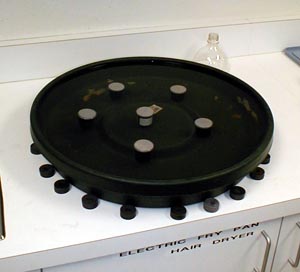
Garden of Magnets
Floating magnets arrange themselves in interesting geometric patterns

Introduction
Two donut magnets when placed into a film can will just barely float in water. When two of these film cans containing magnets are placed side by side with their north poles up, they will repel each other.
Film cans floating inside a circle of repelling magnets will form simple geometrical patterns.
Material
9 or more film cans
A tray, such as a circular plastic container for water, deep enough to float film cans. Plant trays in garden stores, or drip pans from hardware stores (meant to be put under hot water heaters).
Optional A wooden board, plywood or composition board at least 0.5 inch (1 cm)thick, it should be larger than the plastic container. Wood screws, 3/4 inch #10, round head, plus washers. A pencil and a drill.
A large number of 1.25 inch diameter ferrite donut magnets
two for each film can
and two for every 10 cm (4 inches) of circumference of the tray.
Such magnets are available from Radio-Shack or from The Magnet Source.
Packing material (e.g. Styrofoam peanuts) enough to fill the film cans.
Assembly
Make a stack from all of the donut magnets. This will insure that all of their north poles point in the same direction. Remove magnets from the top of the stack, be careful to keep their top sides up as you place them in the film cans and around the tray. The donut magnets will fit into the film cans. Put two donut magnets into each film can. Fill the remainder of the film can with packing material, to keep the donut magnets from flipping over in the cans. Close the lids on the film cans. A film can with two magnets inside will just barely float.
Place the tray onto a table, put piles of two magnets around the outside of the tray with about 10 cm between their centers. Fill the tray with water.
Optional To make a more permanent version. Place the tray into the center of the wood board. Place piles of two magnets around the outside of the tray with about 10 cm (4 inches) between their centers. Use a pencil to mark the center of each magnet pile. Remove the tray and magnets and drill a pilot hole for each wood screw. Place a washer under the head of each screw and screw down the piles of magnets.
To Do and Notice
Place one film can with magnets into the tray of water. Notice that the magnets around the rim repel the film can and that it moves into the center of the tray.
Predict what will happen when a second film can is placed in the tray.
Notice that the two magnets form a straight line through the center of the tray. The two magnets repel each other and are also repelled by the magnets around the rim of the tray.
All of the following patterns are centered on the center of the tray.
Three magnets form an equilateral triangle.
Four make a square.
Five make a pentagon.
Six make either a hexagon or a pentagon with a magnet in the center depending on the place the sixth magnet is added.
Seven will always from a hexagon with one in the center, the final pattern may take a while to form.
Continue adding magnets and making predictions.
What's Going On?
The magnets are all arranged with the same pole (e.g. north) pointing up. Since like poles repel, the piles of magnets repel each other. The magnets around the rim push the floating magnets toward the center while the floating film cans repel each other.
This behavior is a model for atomic and molecular behavior. A quote from Richard Feynman describes the atomic theory," All Things are made of atoms &emdash; little particles that move around in perpetual motion, attracting each other when they are a little distance apart but repelling upon being squeezed into one another."
For the magnet-filled film cans, the balance of forces results in geometrical patterns. The film cans move until the forces on each can are balanced, such a position will be one of minimum energy. In some instances such as those of six film cans there are two different patterns each with a minimum energy.
Actually one of the patterns has a lower energy than the other, however each is a local minimum of energy, any change in the pattern from the local minimum of energy will result in a restoring force which pushes the magnets back into the minimum energy pattern. Even though one energy minimum is lower than the other there is no way for the film cans to get from one position to the other.
See also Garden of magnets - mini.
|
Scientific Explorations with Paul Doherty |
|
17 May 2007 |